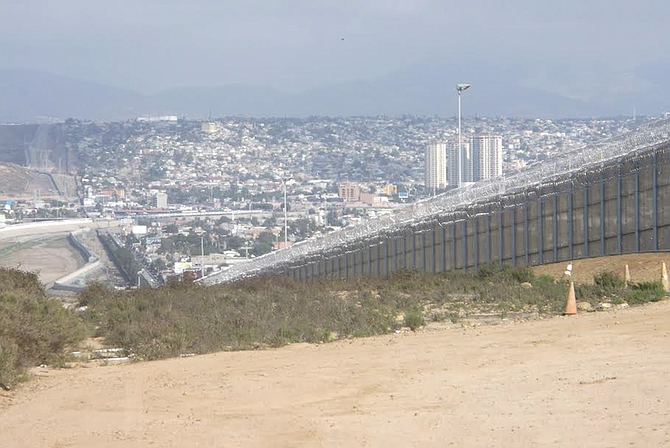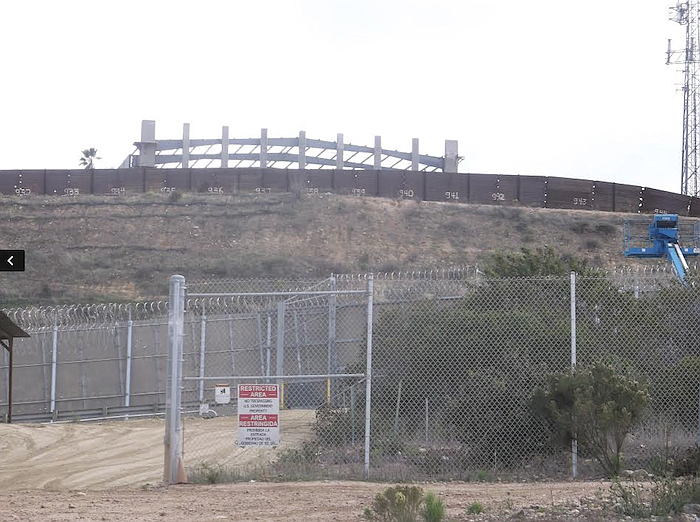 Facebook
Facebook
 X
X
 Instagram
Instagram
 TikTok
TikTok
 Youtube
Youtube

Recently installed razor wire along the border from Imperial Beach to San Ysidro has cut traumatic injuries to fence-jumpers by more than 70 percent. The need for border patrol agents to be stationed at hospitals for the duration of the immigrants' stays has also been reduced.
The razor wire, which discourages people from trying to jump over the 16' fence, has also reduced the number of people trying to cross and the number of assaults on federal agents, according to I.B. station patrol-agent-in-charge Greg Bovino.
No one opposed the installation, which occurred entirely on federal land.

"If you can't get on the fence, you can't jump off of it," Bovino said. "Before the wire, it took a minute and a half to get up and over, and many people jumped. Now it takes five minutes and it gives us time to react, to get there and get them down and safely in custody."
Between October 1, 2014, and January 1, 2015, 28 people entering the U.S. illegally along that stretch of fence suffered traumatic injuries jumping off the fence in the 5.5-mile stretch that starts at the beach. One year later, between October 1, 2015, and Jan. 1, 2016, 8 were injured and taken to the hospital, according to border patrol statistics.
Injuries ranged from a broken leg and ankle bones to traumatic head injuries, he said. In more than one instance, injuries resulted in multiple surgeries to rebuild shattered bodies. In the later quarter, the injuries also tended to be less severe.
The 71-percent reduction in injuries is important not only in terms of human misery, but for the agency and taxpayers, Bovino said. When an injured person in custody is hospitalized, the Border Patrol has to keep two agents at the hospital around the clock until doctors agree the person is healthy enough to be discharged. That's at least six agents per day of hospitalization who are not protecting the border, Bovino said.
"We've been able to keep the illegal aliens and our people out of the hospital," he said. "We had a lot of manpower not protecting the border and it affects morale because our agents would rather be protecting this country than sitting at a hospital."
Taxpayers also foot the bill for the medical care, Bovino said.
The razor-wire installation began in September 2015 along the 16-foot tall secondary fence, which is about 50 yards north of the primary fence. The secondary fence alone substantially reduced the number of people crossing the border, but with the razor wire, apprehensions — which is how the feds count the effectiveness of border enforcement — dropped another 24 percent, while apprehensions along the entire southwest border increased slightly.
The other effect of the razor wire was that it pushed would-be crossers and the professional smuggling rings that traffic in people from harder-to-patrol areas to places where such crossings are more easily detected and thwarted.
In the westernmost three miles of the sector, the border cuts through hillsides and valleys where visibility isn't always great. The razor wire has pushed crossings east, to the flat land by the International Boundary and Water Commission sewage-treatment plant and near the shopping malls, where it's easier to spot the crossers. As a result, apprehensions in those areas have increased, while the hot spots in the hills have cooled off, according to border patrol statistics.


Recently installed razor wire along the border from Imperial Beach to San Ysidro has cut traumatic injuries to fence-jumpers by more than 70 percent. The need for border patrol agents to be stationed at hospitals for the duration of the immigrants' stays has also been reduced.
The razor wire, which discourages people from trying to jump over the 16' fence, has also reduced the number of people trying to cross and the number of assaults on federal agents, according to I.B. station patrol-agent-in-charge Greg Bovino.
No one opposed the installation, which occurred entirely on federal land.

"If you can't get on the fence, you can't jump off of it," Bovino said. "Before the wire, it took a minute and a half to get up and over, and many people jumped. Now it takes five minutes and it gives us time to react, to get there and get them down and safely in custody."
Between October 1, 2014, and January 1, 2015, 28 people entering the U.S. illegally along that stretch of fence suffered traumatic injuries jumping off the fence in the 5.5-mile stretch that starts at the beach. One year later, between October 1, 2015, and Jan. 1, 2016, 8 were injured and taken to the hospital, according to border patrol statistics.
Injuries ranged from a broken leg and ankle bones to traumatic head injuries, he said. In more than one instance, injuries resulted in multiple surgeries to rebuild shattered bodies. In the later quarter, the injuries also tended to be less severe.
The 71-percent reduction in injuries is important not only in terms of human misery, but for the agency and taxpayers, Bovino said. When an injured person in custody is hospitalized, the Border Patrol has to keep two agents at the hospital around the clock until doctors agree the person is healthy enough to be discharged. That's at least six agents per day of hospitalization who are not protecting the border, Bovino said.
"We've been able to keep the illegal aliens and our people out of the hospital," he said. "We had a lot of manpower not protecting the border and it affects morale because our agents would rather be protecting this country than sitting at a hospital."
Taxpayers also foot the bill for the medical care, Bovino said.
The razor-wire installation began in September 2015 along the 16-foot tall secondary fence, which is about 50 yards north of the primary fence. The secondary fence alone substantially reduced the number of people crossing the border, but with the razor wire, apprehensions — which is how the feds count the effectiveness of border enforcement — dropped another 24 percent, while apprehensions along the entire southwest border increased slightly.
The other effect of the razor wire was that it pushed would-be crossers and the professional smuggling rings that traffic in people from harder-to-patrol areas to places where such crossings are more easily detected and thwarted.
In the westernmost three miles of the sector, the border cuts through hillsides and valleys where visibility isn't always great. The razor wire has pushed crossings east, to the flat land by the International Boundary and Water Commission sewage-treatment plant and near the shopping malls, where it's easier to spot the crossers. As a result, apprehensions in those areas have increased, while the hot spots in the hills have cooled off, according to border patrol statistics.
Comments